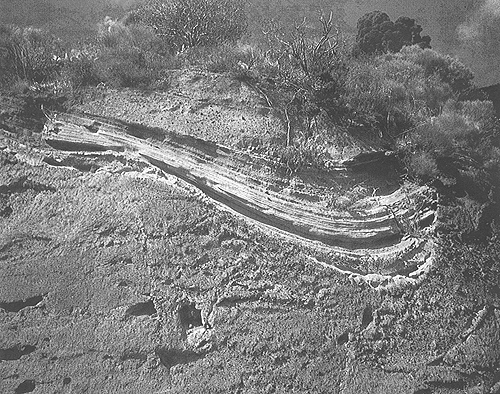
Rounded channel form (scour-and-fill)
Plate 74

Rounded channel form (scour-and-fill)
Plate 74
Another example of channel form in pyroclastic deposits is emphasized by the strong contrast between the filling materials (light and well bedded) and the substratum (structureless, coarser and darker) in this cliff, about 3 m high. The erosional profile is simpler, more rounded, and asymmetrical in comparison with the previous case (plate 73). The filling is monophasic, i.e., made of only one type of materials with a conformable bedding. Moreover, these materials are not reworked from the substratum; they look quite different from it, and are well sorted. They lap on the flanks of the channel form with the meniscus-like attitude already seen in the upper part of plate 73.
The eroded deposits are thick lahar beds, i.e., ash and cinder of fall origin that slid down volcano slopes; slidingor laminar flow produced a chaotic admixture. The laminated fill deposits are, instead, primary; they were emplaced by a turbulent, tractive pyroclastic flow of the ground surge type. Such a flow has a power to erode, and most likely produced both the channel form and its filling in a single event. The structure is thus interpretable as a scour-and-fill. The rounded profile of the scour was carved by eddies of the highly turbulent flow; it is similar to that of smaller structures known as flute marks (see plates 87-91). As for the asymmetry of the profile, it should be the result of centrifugal effects induced by local curvature of the flow path (directed toward the reader).
Pleistocene pyroclastics, Salina Islands, Tyrrhenian Sea.